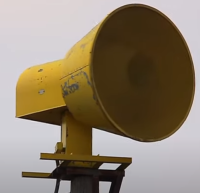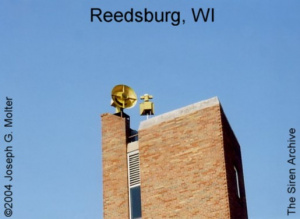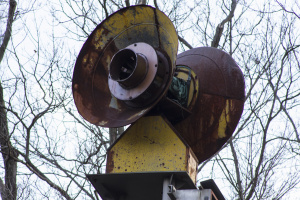500
| Federal Signal 500 series | |
 A 10/12 500-SHTT, located in Abilene, KS. | |
| Company | Federal Enterprises Company
Federal Sign & Signal Company |
|---|---|
| Produced | 1953-1981 |
| Type | Rotational Electromechanical |
| Sound output | 120-130 dB @ 100 ft |
| Frequency | 60 Hz |
| Horsepower | 10 hp (500-SH, SHTT, AT/BT)
15-20 hp (500-DHTT) |
| Voltage | 208-240/480 V 1 or 3 ph |
| Succeeded by | Federal Signal RSH-10 |
The Model 500 is a series of midrange rotational mechanical sirens that was produced by Federal Signal, intended to provide a midrange option for cities who did not want to invest in the longer range, but more expensive Thunderbolt. Unfortunately, this led to the 500 series being overshadowed by the Thunderbolt series and increasing failures of the 500's rotators have led to it becoming rare after its discontinuation in 1981.
Design
The 500 is a simple design, built to be all-enclosed and low-maintenance. It consists of a rotating siren unit placed on top of a stationary stand, which also houses the collector ring tube. The 500 is essentially a rotational version of Federal's various rotational sirens, which include the STH-10 (early 500-SH), Model 5 (later 500-SH), and Model 5T (3rd gen 500-AT). The 500 series of sirens was designed by Federal to be roof-mounted, with a mounting platform built into the siren which would make it easier to install. However, many municipalities chose to ignore this and installed them on poles anyway. it is unknown why exactly Federal chose to do this, but it is entirely possible that Federal did not want to cut into the Thunderbolt's sales, and made it more difficult to install on a pole. This would be the case for the entire production run of the siren.
The 500 makes use of a dual-shaft 10-horsepower AC electric motor, which both drives the chopper and the rotation mechanism. Both the motor and rotation mechanism are protected by a rounded cover, and the sound is projected from a conical projector made of rolled sheet metal. Depending on the model, the siren may have a tubular cylindrical intake or a conical intake. A mesh screen on the projector keeps debris out of the siren. All 500 series siren rotators (minus the 500-DHTT) are belt driven by the chopper motor, using a belt connected to a gear reduction drive, which then drives another belt below the motor which rotates the horn and motor assembly above the stationary rectangular collector ring housing.
Models
1st generation (1953-1960s)

The 500 series was introduced in 1953 and advertised as a midrange alternative to the Thunderbolt siren released the year prior, which was Federal's flagship and most powerful siren at the time. The 500 could output significant noise without a blower, which made it more attractive to buyers who wanted a lower-cost, lower-maintenance design.
There were three models introduced in 1953: The 500-SH, which made use of Federal's C3 1/2 Model 5 or STH-10's rotor and stator, and came exclusively in 8 and 12-port single tone, the 500-SHTT, which came in 9/12 port dual tone and made use of Federal's SD-10's rotor and stator (and is sometimes also referred to as the 500T), and the 500-DHTT, which is covered below. Early 500 series sirens came with larger motor covers, and a much shorter, wider projector horn that was at a steeper angle than later generations. These horns appear to be the lower halves of an SD-10 repurposed into a horn.
Some of these early 500 sirens came with reinforcing bars in the horn, which would stabilize and reinforce the horn as they were prone to warping. Most of these are 500-SH units, with few 500-SHTT units having these reinforcements. Many examples of these early 500-SHTTs can be found around Los Angeles, CA, as part of its decommissioned civil defense system. 500-SH and 500-SHTT sirens both came with 10 hp dual-sided motors, in 1 ph (208 V) or 3 ph (220 V/550 V, similar to CLM sirens) AC power.
2nd generation (1960s-1970)
Sometime in the 1960s, the 500-SH and 500-SHTT would receive a design overhaul. The motor cover was lengthened, and the horn was replaced with a longer, more shallow horn with a mesh screen. This was more effective at concentrating the sound output. The 9/12 port 500-SHTT would be redesigned with a much larger 20.5-inch 10/12 port rotor and stator with small stator ports, as well as using a large conical intake, which improved sound pressure and massively increased the siren's sound output. The rotor used a unique "dual intake" design similar to that of the ACA Cyclone or P-50, maximizing airflow to both rows of ports to improve performance but also increasing drag, causing slow, extended windups that are distinctive to the siren. This rotor can be classified as the dual tone rotor variant of the rotors found on the STH-10 or STL-10. The 500-SH would also be redesigned, now using the smaller rotor and stator from a Federal C3 1/2 Model 5 and receiving a longer cylindrical intake. The 10/12 500-SHTT is known as the loudest of the 500 series.
3rd generation (1970-1981)
In 1970, the 500-SHTT would be redesigned again, with the 10/12 port rotor and stator being discontinued and replaced with a simpler 9/12 rotor and stator with a cylindrical intake, resembling the ones used on the original 500-SHTT. Reusing parts from a different existing siren made the siren much cheaper to produce, as existing parts could be reused. These quickly became the most common model of 500 after its release. Around this time, Federal would also change its naming scheme, with the 500-SHTT being renamed to the 500AT/500BT. This would not apply to the 500-SH, which is still referred to as such. The 500-SH remained unchanged from its second generation counterpart. The 500-SH and the 500A/BT would continue to be produced until sometime around 1981, when the series was discontinued alongside many of Federal's older sirens as Federal wanted to streamline their lineup, and likely did not want sales to cut into the Thunderbolt.
While the 500 series of sirens did see quite a bit of success, it was always overshadowed by its supercharged cousin. Federal seemed to think that the 500 would cut into sales of the Thunderbolt, and as such the 500 series was far less advertised and documented. Flaws in the design of the rotator also proved to be a headache for those who bought them, as in order to replace the lower belt, the entire siren (horn, rotor, motor, ect) has to be disassembled. This has led to many surviving 500s having broken or faulty rotators. The 500AT would see no direct replacement as Federal did away with almost all of its dual tone sirens at that time, while the 500-SH would be indirectly succeeded by the RSH-10 Thunderbeam, and later by the 2001 series and the 508-128. Today, a handful of 500s still survive in service, but many have failing rotators. The rest sit abandoned in place, rusting away.
500-DHTT

The 500-DHTT (sometimes misnamed as the 550-AT) was introduced in 1953 alongside the other models, and was a dual rotor, dual horned rotational siren. The 500-DHTT made use of the rotors from both the 8-port and the 12-port variants of the Federal C3 1/2 Model 7, with one on each side combined made the siren 8/12 port dual tone. The siren made use of a very tall hexagonal rotator, which appears to be the same rotator mechanism as used on the Thunderbolt (though this is unconfirmed), but with a much taller shaft with a triangular cover to allow enough clearance for the horns. One thing to note is that the intake on the 12 port side is significantly longer than the other. The 500-DHTT was offered with 15 hp or 20 hp dual sided AC motors. Due to the two rotors having their own separate projectors, this caused the siren to slowly waver between 8 and 12-port as it rotated.
Around 1957, the siren was redesigned with a taller rotator shaft, which gave the horns better clearance over the rotator. There was also rumored to be a "second generation" 500-DHTT, with improved sound projectors. 50 were supposedly made, however none exist today. It is unknown whether or not these "second generation" DHTTs existed in the first place, with no evidence proving so. One dual rotor siren was thought to be one of these, but it looked nothing like a Federal siren and was removed before it could be verified. The 500-DHTT was a very unpopular siren, due to Federal's poor advertising of the siren, as well as its heavy weight and unsuitability for pole mounting. As a result, roughly 100 500-DHTTs were built, only 7 of which are known to survive as of 2022. Only a single example remains active and in service, in Calhan, CO, with the others sitting abandoned in various states of disrepair.